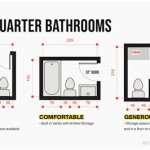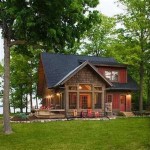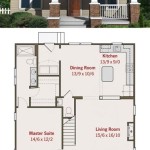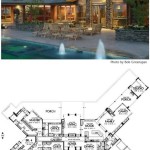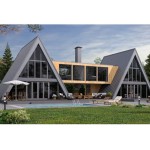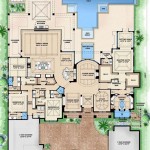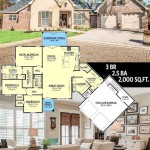House Plans For 2 Family Homes In Georgia, USA
The demand for housing options that accommodate multiple generations or offer rental income opportunities has steadily increased across the United States, including Georgia. Two-family homes, also known as duplexes or multi-generational homes, are growing in popularity as a viable solution. This article explores various aspects of house plans for two-family homes in Georgia, focusing on design considerations, legal compliance, and common architectural styles.
Designing a two-family home involves careful consideration of layout, privacy, and cost-effectiveness. The plans must adhere to local building codes and zoning regulations, which can vary significantly between different counties and cities within Georgia. Furthermore, it's crucial to understand the specific needs of the intended occupants, whether they are family members or tenants.
The initial step in developing house plans for a two-family home is determining the floor plan and layout. This process requires balancing the needs of each unit while maintaining a cohesive architectural design. Considerations include the size of each unit, the number of bedrooms and bathrooms, and the presence of shared or separate spaces.
Key Design Considerations for Two-Family Homes in Georgia
Several key factors should guide the design process of two-family homes. These factors influence the functionality, livability, and market value of the property.
Privacy and Soundproofing: A significant consideration is the privacy between the two units. Soundproofing is vital to minimize noise transmission between the living spaces. This can be achieved through the use of insulation in walls and floors, solid-core doors, and strategically placed windows. Separate entrances and outdoor living spaces also contribute to maintaining privacy for each unit.
Accessibility and Universal Design: As multi-generational living becomes more common, accessibility is a critical element. Incorporating universal design principles, such as wider doorways, ramps, and accessible bathrooms, can make the home suitable for residents of all ages and abilities. This also increases the long-term value and marketability of the property.
Energy Efficiency: Georgia experiences hot summers and mild winters, making energy efficiency a paramount concern. Incorporating energy-efficient features, such as high-performance windows, proper insulation, and energy-efficient appliances, can significantly reduce utility bills and environmental impact. Solar panels are also a popular option in Georgia, offering long-term energy savings and increasing the home's appeal to environmentally conscious buyers or renters. This may necessitate a structural assessment to ensure the roof can handle the load of solar panels. Furthermore, the orientation of the building on the lot should be carefully considered to maximize solar gain in the winter and minimize it in the summer.
Shared vs. Separate Utilities: Another crucial decision involves whether to have shared or separate utility meters for each unit. Separate meters allow each unit to be responsible for its own utility costs, which simplifies billing and reduces potential conflicts between occupants. However, installing separate meters can increase the initial construction costs. Shared utilities are less expensive to install initially but require a system for dividing the bills equitably, which can be a source of contention between occupants. The preferred approach often depends on the relationship between the occupants and the landlord's preference.
Parking and Outdoor Space: Adequate parking is essential, especially in urban areas. The number of parking spaces should comply with local zoning regulations and accommodate the needs of each unit. Outdoor space, such as a patio, deck, or yard, should be provided for each unit, either separately or as a shared amenity. Landscaping can enhance the curb appeal of the property and provide additional privacy.
Compliance with Building Codes and Zoning Regulations: Building codes and zoning regulations in Georgia govern various aspects of construction, including building height, setbacks, lot coverage, and occupancy requirements. These regulations vary across different jurisdictions. It is imperative to consult with local authorities and ensure that the house plans comply with all applicable codes and regulations before commencing construction. Failure to comply can result in costly delays, fines, or even the rejection of the building permit.
Navigating the regulatory landscape often requires the expertise of a qualified architect or engineer familiar with local building codes and zoning ordinances in Georgia. They can assist in preparing the necessary documentation and obtaining the required permits.
Architectural Styles Suitable for Two-Family Homes in Georgia
Georgia's architectural landscape is diverse, with influences ranging from traditional Southern styles to modern designs. Selecting an architectural style that complements the surrounding neighborhood and meets the aesthetic preferences of the occupants is essential.
Craftsman Style Duplex: The Craftsman style is characterized by its emphasis on natural materials, handcrafted details, and a welcoming front porch. This style is well-suited for two-family homes due to its inherent flexibility in design. A Craftsman duplex can feature separate entrances for each unit, a shared front porch, and distinctive architectural details such as exposed rafters, tapered columns, and multi-pane windows. The interior layout can be customized to meet the specific needs of each unit, while maintaining a cohesive exterior appearance.
Ranch Style Duplex: Ranch-style homes are known for their single-story layout, open floor plans, and low-pitched roofs. This style is particularly suitable for two-family homes accommodating elderly residents or those with mobility limitations. A Ranch-style duplex can be designed with two separate wings, each with its own entrance, or with a shared central entrance leading to separate units. The open floor plans provide ample living space and can be easily adapted to accommodate universal design features.
Traditional Southern Style Duplex: Traditional Southern architecture often features large front porches, columns, and symmetrical designs. This style can be adapted for two-family homes by incorporating a shared front porch with separate entrances for each unit. The interior layout can be designed with a central hallway leading to separate living spaces, each with its own bedrooms, bathrooms, and kitchen. The exterior can be adorned with traditional Southern architectural details, such as shutters, gabled roofs, and decorative trim.
Modern Farmhouse Style: The modern farmhouse style combines the rustic charm of traditional farmhouses with contemporary design elements. This style is gaining popularity in Georgia due to its blend of comfort and sophistication. A modern farmhouse duplex can feature a white exterior with black accents, a large front porch, and exposed beams. The interior layout can incorporate open floor plans, natural light, and modern amenities, while maintaining a cozy and inviting atmosphere.
Legal and Financial Considerations
Constructing or renovating a two-family home involves several legal and financial considerations that must be addressed to ensure a smooth and compliant project.
Property Ownership Structure: Determining the property ownership structure is critical. Options include individual ownership of each unit, co-ownership, or ownership through a limited liability company (LLC). Each option has different legal and tax implications. Individual ownership allows each unit to be sold separately, while co-ownership involves shared responsibility for maintenance and expenses. An LLC can provide liability protection and simplify the management of rental income.
Financing Options: Securing financing for a two-family home may require different loan products than those used for single-family homes. Lenders typically consider factors such as the rental income potential, the creditworthiness of the borrowers, and the loan-to-value ratio. Options include conventional mortgages, FHA loans, and investment property loans. It's advisable to consult with a mortgage lender to explore the available financing options and determine the best fit for the project.
Rental Agreements and Tenant Rights: If one or both units will be rented out, it is essential to have legally sound rental agreements that comply with Georgia's landlord-tenant laws. These agreements should clearly outline the terms of the tenancy, including the rent amount, payment schedule, security deposit, and responsibilities for maintenance and repairs. Landlords must also be aware of tenant rights, such as the right to privacy, the right to a habitable dwelling, and protection against discrimination. Failing to comply with these laws can result in legal disputes and financial penalties.
Insurance Coverage: Adequate insurance coverage is crucial to protect against potential risks, such as fire, storms, and liability claims. Landlords should obtain landlord insurance policies that cover the building, liability, and loss of rental income. Tenants should also obtain renters insurance to protect their personal belongings. The insurance policies should be reviewed regularly to ensure they provide adequate coverage.
Tax Implications: Owning a two-family home has various tax implications, including deductions for mortgage interest, property taxes, and depreciation. Rental income is generally taxable, but landlords can deduct expenses such as repairs, maintenance, and insurance. It is advisable to consult with a tax professional to understand the specific tax implications of owning a two-family home and to ensure compliance with all applicable tax laws.
In conclusion, planning and executing a two-family home project in Georgia requires careful attention to design, legal compliance, and financial considerations. By addressing these factors, homeowners and investors can create functional, aesthetically pleasing, and financially viable properties that meet the diverse housing needs of the community.

Duplex House Plans Floor Designs Houseplans Com

12 Simple 2 Bedroom House Plans With Garages Houseplans Blog Com

House Plans Floor Blueprints

Top 10 Duplex Plans That Look Like Single Family Homes Houseplans Blog Com

Southern House Plans Style Home Designs The Designers

Plan 75977 Modern Style House Floor With Covered Lanai

12 Simple 2 Bedroom House Plans With Garages Houseplans Blog Com

Southern House Plans Style Home Designs The Designers
2 Story House Plans Blog Dreamhomesource Com

New Construction Houses For In Newnan Ga Homes Com
Related Posts


